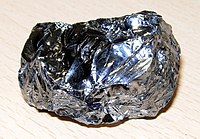
Photo from wikipedia
In order to increase the efficiency of photovoltaic solar cells, photon absorption in an extended range of the solar spectrum is necessary, for example by means of up-conversion (UC) of… Click to show full abstract
In order to increase the efficiency of photovoltaic solar cells, photon absorption in an extended range of the solar spectrum is necessary, for example by means of up-conversion (UC) of sub-bandgap photons to minimize transparency losses. While lanthanide (Ln)-doped luminescent layers may be deposited on cell materials to achieve spectral conversion by methods like CVD or PVD, sol-gel (SG) processing is a low-cost technology which may be a good alternative for this purpose. In this work, Ln-doped SG-derived active layers have been deposited by spin-coating onto c-Si substrates for frequency conversion, with particular emphasis on UC, involving host matrices like aluminosilicate glass and titania ceramic doped with the activator/sensitizer pair Er/Yb. White light emitting diodes (WLEDs) based on Ln-doped phosphors still have efficiency limitations, namely because the Stokes shift from UV/blue LED excitation to the emitted lower frequency visible light converts some of the pump energy into heat. However, if white light generation (WLG) is achieved through IR-pumped UC instead, the cost of the LED lamp will be reduced, while the energy loss from Stokes shift can be minimized. SG synthesis of Ln-doped oxide phosphors for UC in WLG has been achieved (Er/Yb and Tm/Er/Yb doping), based on aluminosilicate glass matrices. Photonic crystal-assisted UC emission has also been demonstrated in a Tm/Yb-doped Fabry–Perot microcavity (MC). The different materials have been characterized by XRD, SEM, ellipsometry and photoluminescence (PL) spectroscopies and their light emission has been analyzed with the help of CIE chromaticity diagrams. Up-converting Er3+/Yb3+-doped aluminosilicate glass materials for energy applications. 1.6Tm3+/0.3Er3+/20Yb3+-doped aluminosilicate glass yielded CIE coordinates at the white light point. Photonic crystal-assisted enhanced UC emission was obtained in a Tm3+/Yb3+-doped Fabry–Perot microcavity. Up-converting Er3+/Yb3+-doped aluminosilicate glass materials for energy applications. 1.6Tm3+/0.3Er3+/20Yb3+-doped aluminosilicate glass yielded CIE coordinates at the white light point. Photonic crystal-assisted enhanced UC emission was obtained in a Tm3+/Yb3+-doped Fabry–Perot microcavity.
Journal Title: Journal of Sol-Gel Science and Technology
Year Published: 2020
Link to full text (if available)
Share on Social Media: Sign Up to like & get
recommendations!